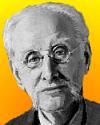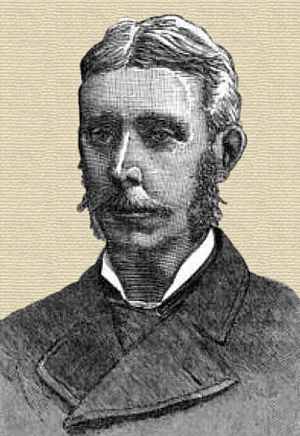 (source)
(source)
|
Rookes Evelyn Bell Crompton
(31 May 1845 - 15 Feb 1940)
British engineer and inventor.
|
Rookes Evelyn Bell Crompton - Biography
from The Electrical Journal (1884)
[p.26] CROMPTON, Rookes Evelyn Bell: Born near Thirsk in Yorkshire 1845, educated at Elstree Hill School, Harrow School, and in Paris; entered the army, and appointed to the Rifle Brigade in 1863. Served with his regiment in India until 1869; from 1869 to 1875, held an appointment under the Department of Public Works as engineer in charge of the Government steam train. During this time he carried out for the Indian Government a long series of experiments on traction by steam on the roads of India. In 1876, left the service and became a partner in the firm of T. H. P. Dennis and Co., of Chelmsford. A year later he became engineer in chief of the Stanton Iron Works Company. For this company he designed and superintended the construction of their foundry, which is one of the largest in the United Kingdom. Shortly after the completion of the foundry, necessity for working continuously day and night led him to study the possibility of adopting the electric light, which at that date, 1877, was a novelty in this country. Early in 1878 he purchased for the company a plant of two Gramme machines and two Serrin lamps. The following year he commenced the manufacture of electric light apparatus in a small building attached to Messrs. Dennis’s works at Chelmsford. His first inventions related to burning arc lamps in partial vacua, and to the improvements in the arc lamps themselves. These improvements were exhibited at the Agricultural Show in Kilburn in 1878 and at the exhibition of electric light apparatus held at the Albert Hall in 1879. The lamps were made for practical use, and a considerable sale was soon obtained for them. In 1879, through the instrumentality of Mr. Brown, the well known tramway engineer of Winterthur in Switzerland, Mr. Crompton made the acquaintance of Mr. Bürgin, of Basle, who had just brought out his dynamo electric machine. Mr. Crompton at once laid out works on a considerable scale at Chelmsford for the construction of this machine. In conjunction with Mr. Bürgin he introduced considerable improvements, and converted the original machine, which was only capable of driving one arc lamp, into one giving a current of higher E.M.F., and capable of driving four or five lights in series. The lighting at Queen-street Station, Glasgow, King’s Cross Station, London, the Bricklayers’ Arms, London, and the Mansion House, are instances of works successfully undertaken about this period. In 1879 Mr. Swan invited Mr. Crompton to Newcastle to see the incandescent lamp tried on a commercial scale, and the question of manufacturing dynamo machines suitable for working the incandescent system was seen to be of the greatest importance. In 1881 Mr. Crompton exhibited largely at the Exposition International d’Electricité at Paris, and obtained one of the few gold medals awarded to English firms; and in the following year he again exhibited at the Crystal Palace and obtained another gold medal. Shortly after this he commenced the investigation of the subject of making self-regulating dynamo machines, and with the assistance of Mr. Kapp, who had become his works manager, he brought out the now well-known system of winding the field magnets of dynamos with series in addition to shunt coils. To machines thus wound he gave the name of “compound” machines, and this name has been generally adopted by makers and users of such dynamos. The invention of compound winding has been claimed for others, but it remains a fact that the first dynamo machines made practically self-regulating by the compound principle were those made and set to work by Messrs. Crompton for Mr. Coope at Berechurch Hall, near Colchester, in the spring of 1882.
Believing that the best method of supplying the electric light to the public in their private houses would be in the nature of a co-operative supply, similar to that of gas and water, Mr. Crompton took an active part in the enlargement of the original Swan Company into the Swan United Company, hoping thereby to form a powerful corporation for the supply of electric lighting to large districts in London. He also devoted a great deal of time and attention to the Electric Lighting Act, and subseqnently to obtaining from the Board of Trade provisional orders for the Swan United Company, and for other companies, for lighting various parts of London, Birmingham, &c. He prepared most of the technical information for Mr. Moulton, enabling that gentleman to draft the provisional orders which were afterwards adopted by the Board of Trade with but slight modification as their model provisional order. He protested in the strongest terms against the introduction of the 21 years’ purchase clause, which has been considered so fatal to the electric light companies. Mr. Crompton has never sold any of his patents, although at the time of the electric light mania he had many tempting offers to do so. Seeing that over speculation was likely to retard for many years the accomplishment of the house-to-house electric lighting on a large scale, he again turned his attention to the laying down of isolated installations and to the general improvement of electric light machinery, and with the result that during the last three years he has, either alone or in conjunction with other co-workers, brought out a long series of inventions in arc lighting, electric conductors, street mains, accumulators, dynamo electric machinery, and electric governor apparatus for steam engines and other prime movers. During the last two years he has been engaged in perfecting a new type of dynamo machine, which has given remarkable results, far exceeding those he was able to obtain from the Bürgin or any of the contemporary machines. The development of his works at Chelmsford has gone on hand in hand with the development of electric lighting, although, as we have seen above, these works were only commenced in 1878. In this year, 1884, they cover several acres of ground, and employ over 300 men.
We believe that Mr. Crompton, in conjunction with Mr. Norman Lockyer, F.RS., investigated spectroscopically and otherwise the varying conditions of the electric arc from the point of contact to the complete breaking of the circuit; but no detailed results of this investigation have as yet been published. He was also greatly interested in the experiments which proved the lighting of mines by electricity practicable.
It is sometimes unfortunate that the greater portion of periodical technical literature is anonymous, so that but few people know the authors to whom they are indebted for valuable information. Mr. Crompton has greatly enriched technical literature either by writing or otherwise communicating information, and has contributed several papers to the Transactions of learned societies, principally the Society of Telegraph Engineers, of which society he is a member of the council. So far as we know, only a small work on electric lighting has been published independently, although some of the papers have been republished by Messrs. Spon, of Charing Cross.
- 31 May - short biography, births, deaths and events on date of Crompton's birth.
- Children of Light: How Electrification Changed Britain Forever, by Gavin Weightman. - book suggestion.





